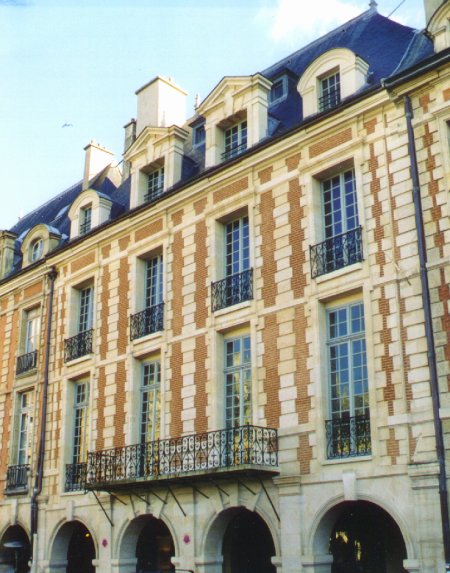| Intranet | Français | English | Español | عربي |

In 1559, Henri II mortally wounded in a tournament, was taken along to the "Hotel des Tournelles" where he subsequently died. Catherine de Médicis decided for this reason to destroy it. In 1605, Henri IV, her son, decides to have a place built to set there at the origin, silk manufactures. The work is completed in 1612. The place is made up of 36 pavilions (9 on each side).
The place quickly becomes very fashionable for nearly half a century and the court entourage are having sumptuous residences built in the district of the Marais.
Obviously deprived of its initial name of Place Royal during the French Revolution and then named in 1792 "Place de l'Indivisibilité" ("Place of the Indivisibility"), it will take in 1800 the name of the first department to have paid its taxes, the Vosges. During the Restoration, it takes again its name of "Place Royale". It is only with the III République that it is definitively called "Place des Vosges".
The facades are carried out in stuc brick (plaster of exterior tinted in red brick with joints first dug out and then filled up in white) directly applied on real brick. This solution was adopted because the stuc brick allows a quality of aspect and behavior that did not permit the brick support of a rather poor quality. The framings and the jambs are in stone.
In addition, the arcades which run all around the square have faux-brick vaults separated by faux-stone ribs.
Technical aside : the Stuc Brick
It is a plaster or a plaster & lime tinted in the mass in red (here a Coating of Montmorency).
It is implemented on a thickness of 1 cm to 3 cm or 3/8 to 1 1/8 inch (in the ancient stuc, it was often of a light thickness on a thick white rough-trimming , in order to save pigment) and finished by cutting with the berthelet ( sharp rake).
A few days after (at least 48 hours to avoid spalls), the joints are dug with the jointer tool.
Then these joints are filled out of white plaster & lime without concern for overflowing.
Indeed, the whole of the surface is then "refreshed", i.e. "peeled" on a 1 mm thickness. The joints then appear perfectly neat.
Note 1 : the technique of the stuc pierre with white joints is exactly the same : only the color and the skin change.
Note 2 : the width and the disposition of the joints play a great part in the final aspect: they varied much according to the periods. For this reason, they sometimes even make it possible to date the facade.
Note 3 : video of implementation